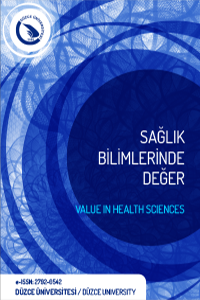Batı Karadeniz Bölgesi Düzce İli'ndeki Yenidoğan İşitme Taraması Sonuçları
ABSTRACT
Amaç: Düzce Atatürk Devlet Hastanesi’nde yapılan yenidoğan işitme tarama sonuçlarını değerlendirmek ve güncel literatür eşliğinde tartışmak amaçlanmıştır.
Gereç ve Yöntemler: Çalışmamızda Ocak 2011- Aralık 2018 tarihleri arasında Düzce Atatürk Devlet Hastanesi’nde işitme taraması yapılan 20071 yenidoğanın işitme tarama sonuçları retrospektif olarak değerlendirildi. Mülteciler çalışmaya dahil edilmedi. İlk teste gelen ve risk faktörü olmayan yenidoğanlar uyarılmış transient otoakustik emisyonlar (TEOAE) ile değerlendirildi. Birinci taramadan kalan yenidoğanlar 15 gün sonra tekrar TEOAE ile değerlendirildi. İkinci tarama testinden kalanlar üçüncü kez işitsel beyin sapı yanıt ile (ABR) değerlendirildi. Risk faktörü olan yenidoğanlar ilk olarak ABR ile değerlendirildi. İlk testten kalanlar ikinci kez yine ABR ile değerlendirildi.
Bulgular: Toplam 20071 yenidoğanın 62 (%0,30) tanesinde işitme kaybı mevcuttu. 35 (%0,17) tanesinde tek taraflı 27 (%0,13) ünde ise çift taraflı idi.
Sonuç: İşitme kayıplı bebeklerin rehabilitasyonu için tedavilerinin mümkün olduğunca erken dönemde başlanması gerekmektedir. Yenidoğan işitme tarama testleri uzun yıllardır ülkemizde başarıyla uygulanan ve işitme kayıplı bebeklerin tespit edilmesini sağlayan bir tarama programıdır. Bu tarama programı ile işitme kayıplı bebekler erken dönemde tespit edilerek tedavi ve rehabilitasyonları sağlanabilmektedir. Çalışmamızda ülkemizde yapılan diğer işitme tarama sonuçlarıyla uyumlu olarak bulunmuştur.
Anahtar Kelimeler:
Yenidoğan, işitme kaybı, otoakustik emisyon, işitsel beyin sapı yanıtı
Newborn Hearing Screening Results of Duzce Province in the Western Black Sea Region
ABSTRACT
Aim: We aimed to evaluate the results of newborn hearing screening (NHS) conducted at Düzce Atatürk State Hospital, and review the results with the relevant literature.
Material and Methods: The hearing screening results of 20071 newborns whose hearing screening was conducted at Düzce Atatürk State hospital between January 2011 and December 2018 were evaluated retrospectively in this study. Refugees were not included in the study. Newborns without risk factors who came to the first test were evaluated with transient evoked otoacoustic emissions (TEOAE). If they failed from the first screening test were evaluated again 15 days later with TEOAE. Newborns who failed the second screening test were evaluated a third time with ABR. Newborns with risk factors were first evaluated with auditory brainstem response (ABR).The risky newborns who failed the first screening test were evaluated second time with ABR.
Results: Hearing loss was present in 62 (0.30%) of the 20071 newborns and was unilateral in 35 (0.17%) and bilateral in 27 (0.13%) subjects.
Conclusion: For the rehabilitation of babies with hearing loss, their treatment should be started as early as possible. Newborn hearing screening tests are a screening program that has been successfully applied in our country for many years and enables the detection of babies with hearing loss. With this screening program, babies with hearing loss can be detected at an early stage and their treatment and rehabilitation can be provided. The results of our study are consistent with other hearing screening results from our country.
Keywords:
Newborn, Hearing Loss, otoacustic emission, auditory brainstem response,
___
- Thompson DC, McPhillips H, Davis RL, Lieu TL, Homer CJ, Helfand M. Universal newborn hearing screening. Summary of evidence. JAMA. 2001; 286(16): 2000-10.
- Oudesluys-Murphy AM, Van Straaten HL, Bholasingh R, Van Zanten GA. Neonatal hearing screening. Eur J Pediatr. 1996; 155(6): 429-35.
- Teufert KB, De La Cruz A. Advances in congenital aural atresia surgery: Effects on outcome. Otolaryngol Head Neck Surg. 2004; 131(3): 263-70.
- Erenberg A, Lemons J, Sia C, Trunkel D, Ziring P. Newborn and infant hearing loss: detection and intervention. American Academy of Pediatrics. Task force on newborn and infant hearing. Pediatrics. 1999; 103(2):527-30.
- Thornton AR, Kimm L, Kennedy CR. Methodological factors involved in neonatal screening using transient-evoked otoacustic emissions and automated auditory brainstem response testing. Hearing Research. 2003; 182: 65-76.
- Kemp DT, Ryan S, Bray P. A guide to effective use of otoacoustic emissions. Ear Hear. 1990; 11(2): 93-105.
- Kenna MA. Neonatal hearing screening. Pediatr Clin N Am. 2003; 50(2): 301-13.
- Paludetti G, Ottaviani F, Fetoni AR, Zuppa AA, Tortorolo G. Transient evoked otoacustic emissions in new-borns: normative data. Int J Pediatr Otorhinolaryngol. 1999; 47(3): 235-41.
- World Health Organization. Newborn and Infant Hearing Screening: current issues and guiding principles for action. Geneva. WHO Press, 2010:14.
- Yucel A, Alataş N, Yucel H, Gulluev M, Ozsoz E, Uğur C. Newborn hearing screening results of refugees living in our city and the factors affecting the results, Int J Pediatr Otorhinolaryngol. 2019; 123: 187-90. https://doi.org/10. 016/j.ijporl.2019.05.019.
- Cıkrıkcı S, Deniz H, Gulşen S. Comparison of hearing screening results of Syrian refugees and Turkish newborns. Int J Pediatr Otorhinolaryngol. 2020; 135: 110095. https://doi.org/ 10.1016/j.ijporl.2020.110095.
- Kılıçaslan S, Kılıçaslan R, Uluyol S, Gür M H. Van bölgesi yenidoğan işitme tarama sonuçları ve literatür taraması. KBB ve BBC Dergisi. 2017; 25 (3): 25-30 https://doi.org/10.24179/kbbbbc.2016-54397. Genç GA, Başar F, Kayıkçı ME, Türkyılmaz D, Fırat Z, Duran Ö. Hacettepe Üniversitesi yenidoğan işitme taraması bulguları. Çocuk Sağlığı ve Hastalıkları Dergisi. 2005; 48: 119-24.
- Çelik İ, Canpolat FE, Demirel G, Eras Z, Sungur VG, Karaer B, et al. Zekai Tahir Burak Women’s Health Education and Research Hospital newborn hearing screening results and assessment of the patients. Turk Pediatri Ars. 2014; 49(2): 138-41.
- Kucur C, Kınış V, Özdem Ş, Kucur SK, Newborn hearing screening results at Zeynep Kamil Women and Children Diseases Education and Research Hospital. Kulak Burun Bogaz Ihtis Derg. 2012; 22(1): 38-42.
- Baydar Y, Pınar E, Katılmış H, Soy FK, Çamlı C. The results of newborn hearing screening test and its significance Tepecik Eğit Hast Derg. 2012; 22 (2): 93-6.
- Övet G, Balcı YI, Canural R, Çövüt İE, Bekçi Ş, Erbil N, ve ark. Yenidoğan işitme taraması sonuçlarımız. Adnan Menderes Üniversitesi Tıp Fakültesi Dergisi. 2010; 11(1): 27- 9.
- Yılmaz B, Küçükbayrak B. Results of newborn hearing screening. Abant Medical Journal. 2013; 2(3): 204-7.
- Yayın Aralığı: Yılda 3 Sayı
- Başlangıç: 2022
- Yayıncı: Düzce Üniversitesi
